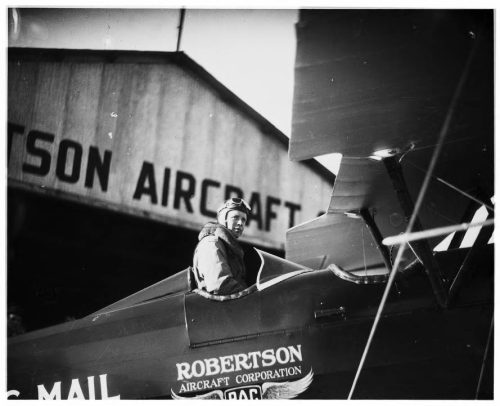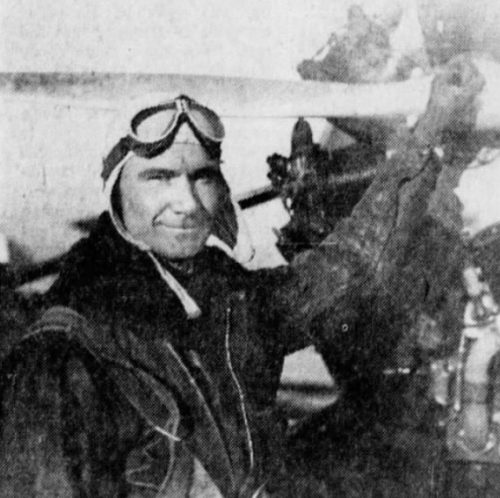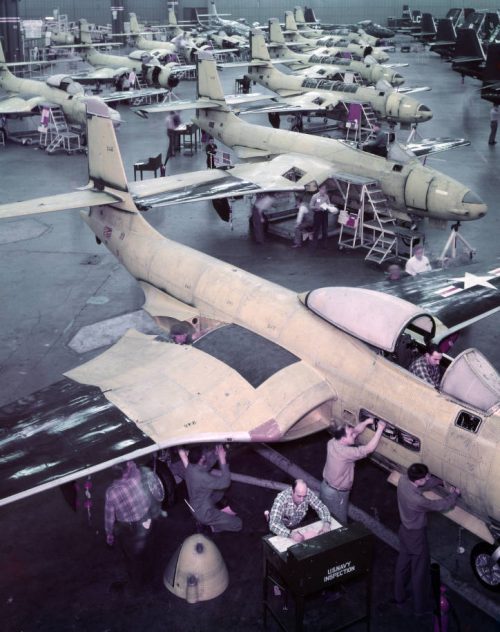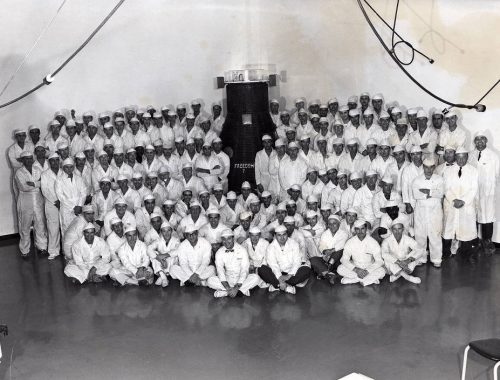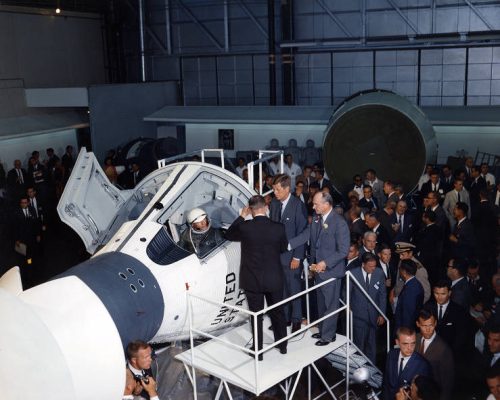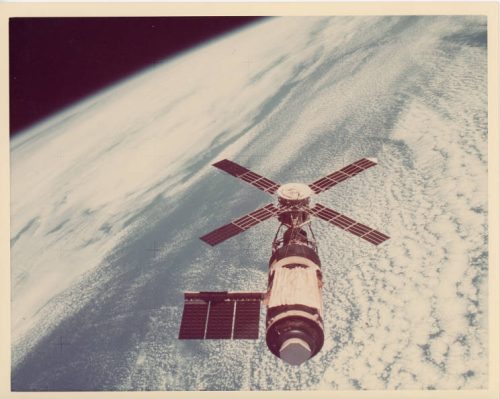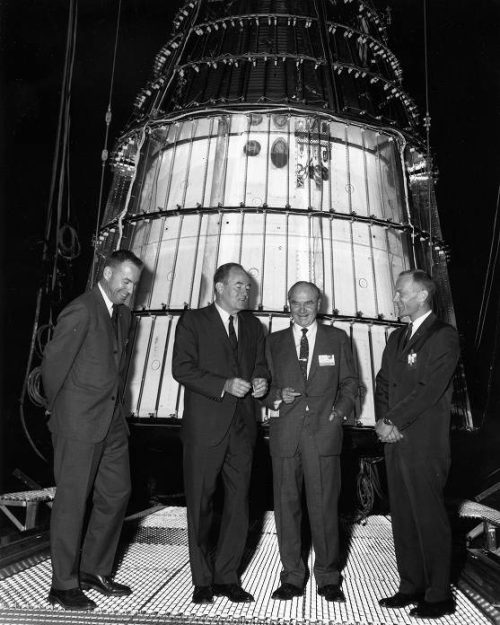![McDonnell James S. McDonnell, Jr., ca. 1970. [50 Years of Service to the Community, the Nation, and the World: 1920, 1970, p. 1. SHS REF H235.97 M146]](https://historicmissourians.shsmo.org/wp-content/uploads/2024/09/McDonnell-300x350.jpg)
James S. McDonnell, Jr.
Introduction
An aviator, engineer, and businessman, James S. McDonnell Jr. is best known as the founder of McDonnell Aircraft Corporation in St. Louis. From the days of propeller airplanes to the space age, he guided a company that was a pioneer in commercial, military, and space flight.
Early Life
James Smith McDonnell Jr. was born in Denver, Colorado, on April 9, 1899, to James S. McDonnell Sr. and Susie Belle Hunter. Though born in Colorado, McDonnell spent his youth in Arkansas, where his parents managed two general stores. He attended local schools and graduated from Little Rock High School in 1917.
After high school, McDonnell briefly enrolled at Princeton University before serving in the US Army during World War I. McDonnell went back to Princeton after the war and completed a bachelor’s degree in physics in 1921. Inspired by the still new technology of airplanes, McDonnell reached a crossroads in his life in the early 1920s. He wanted to continue his education by going to graduate school, yet he also wanted to begin working with airplanes through military training with the US Army Air Corps. He decided to study aeronautical engineering at the Massachusetts Institute of Technology, eventually earning a master’s degree in that field. But he also enrolled in the Army Air Corps Flying School in Texas, where he met Charles Lindbergh, who a few years later became famous as the first pilot to fly solo across the Atlantic Ocean.
"Doodlebug"
Due to his academic and military experience, McDonnell spent the rest of the 1920s working for various aircraft companies around the United States, including Huff Daland, Consolidated Aircraft Company, the Stout Metal Airplane Division of Ford Motor Company, and Hamilton Aero Manufacturing Company. Eager to branch out on his own, he soon established his own company, J. S. McDonnell and Associates. One of the company’s first aircraft, known as the “Doodle Bug,” was entered in a nationwide competition for new airplanes in 1927. The “Doodle Bug” did well in early test flights, but mechanical setbacks forced McDonnell to ask for more time to get the airplane to New York for the final competition. After it was damaged during an emergency landing, McDonnell’s company withdrew the “Doodle Bug” from the competition. Soon after, with the start of the Great Depression, J. S. McDonnell and Associates was one of the many companies that had to close as the nation and its economy went through hard times.
McDonnell Aircraft Corporation
After he closed his company, McDonnell worked for several other aircraft companies during the 1930s. He was eventually promoted to chief engineer at Glenn L. Martin Aircraft Company, but he was eager to start another company of his own. In 1939, he established McDonnell Aircraft Corporation in St. Louis. St. Louis was a surprising choice, because most aircraft companies at the time were near major cities on the East and West Coasts of the United States. Yet McDonnell pointed out that as the eighth-largest city in the United States and home to a large airport at Lambert Field, St. Louis was a good place for a company that designed and built airplanes.
At first, McDonnell Aircraft Corporation employed only ten people and shared office space in a small building rented from American Airlines. However, the company quickly grew as World War II dramatically increased the number of military contracts between the US government and private businesses. By the end of the 1940s, McDonnell Aircraft Corporation was the largest supplier of airplane parts in the region, and more than five thousand people worked for the company. With the introduction of jet engines, McDonnell Aircraft Corporation developed new jet aircraft such as the Phantom, Banshee, Demon, and Voodoo. Competition with the Soviet Union during the Cold War helped McDonnell’s aircraft program as well, boosting the company’s up-and-coming rocket program. By the mid-1950s, the company employed about fourteen thousand workers.
Mercury & Gemini
While McDonnell Aircraft Corporation’s airplanes established it as one of the premier aeronautical companies in the United States, a new chapter was about to begin. The National Aeronautics and Space Administration (NASA)’s decision to select McDonnell as a main contractor on the new Mercury space project launched the company into the stratosphere. Begun in 1958, Project Mercury was the United States’ first serious attempt at manned space flight. NASA hoped that each mission would put an astronaut into space and return them safely back to Earth. When Soviet cosmonaut Yuri Gagarin completed the first orbit of Earth in April 1961, it put extreme pressure on NASA and McDonnell to succeed. But three trips around Earth by American astronauts soon showed that the US space program was catching up to the Soviets.
As American astronauts completed their first space flights, NASA was already thinking of the next steps in the race to the moon: Project Gemini and Project Apollo. While an Apollo mission would be the first to reach the moon, Gemini, which began in 1961, served as a bridge between the Earth orbit flights of Mercury and the moon landings of Apollo. As with Mercury, McDonnell Aircraft Corporation was selected to design the Gemini capsules, which would hold two astronauts instead of just one. Project Gemini lasted until 1966, when NASA began the Apollo missions. Apollo 11 landed the first humans on the moon in 1969.
McDonnell Douglas
Though it had played a crucial role in the development of Mercury and Gemini, McDonnell Aircraft Corporation was not selected as a contractor for the Apollo missions, largely due to NASA’s efforts to spread out the number of companies working with them. Instead of working on Apollo, James S. McDonnell spent the mid-1960s guiding the company through a merger with Douglas Aircraft Company, a California-based aerospace company best known for its DC airplanes used in commercial air travel. McDonnell Douglas was established in 1967, with James McDonnell serving as its chief executive officer. The company kept its headquarters in St. Louis but also had operations at the former Douglas Aircraft Company facility in California.
The main goal of McDonnell Douglas in its first years was to combine the two merged companies’ successes in military and commercial aircraft. Yet McDonnell Douglas became best known in the 1970s for its work on Skylab, an ambitious project that put the first US space station into orbit. Launched in 1973, Skylab allowed astronauts and scientists to perform experiments and observations in space that could not be done on the ground or within Earth’s normal field of gravity. Designed for limited operations, Skylab stayed in orbit until 1979, when it reentered Earth’s atmosphere and was destroyed.
Legacy
Having taken his company from a small rented building at St. Louis’s Lambert Field to the far reaches of Earth’s orbit, James S. McDonnell Jr. became a revered figure not only within the halls of McDonnell Aircraft Corporation and McDonnell Douglas, but also in the larger aerospace community. By the time McDonnell passed away on August 22, 1980, the company that bore his name was the largest private employer in Missouri.
After his death, McDonnell Douglas merged with Boeing in 1997. Though he did not live to see the growth of his company through the rest of the twentieth century, James S. McDonnell’s legacy can still be seen throughout Missouri. In the St. Louis area, he is the namesake for McDonnell Park, McDonnell Planetarium at the Saint Louis Science Center, McDonnell Hall and the McDonnell Center for the Space Sciences at Washington University, and James S. McDonnell Boulevard on the north side of St. Louis–Lambert International Airport. A bronze bust of him is featured in the Hall of Famous Missourians at the state capitol in Jefferson City.
Text and research by Sean Rost
References and Resources
For more information about James S. McDonnell, Jr.’s life and career, see the following resources:
Society Resources
The following is a selected list of books, articles, and manuscripts about James S. McDonnell, Jr. in the research centers of The State Historical Society of Missouri. The Society’s call numbers follow the citations in brackets.
Articles from the Newspaper Collection
- “Capsules for 18-Orbit Flight in the Works at McDonnell.” St. Louis Globe-Democrat. February 21, 1962. p. 3A.
- “J. S. McDonnell Dies; Aerospace Pioneer.” St. Louis Post-Dispatch. August 22, 1980. pp. 1, 19.
- McCoy, Alvin. “Missouri’s Vital Role in Space.” Kansas City Star. January 6, 1963. pp. 1H, 2H.
- “McDonnell Aircraft Signs U. S. Contract.” St. Louis Star-Times. May 12, 1941. p. 8.
- “McDonnell Co. and Douglas Aircraft Firm Plan to Merge.” St. Louis Post-Dispatch. January 20, 1967. pp. 1A, 7A.
- “McDonnell Corp. Taking Most of Airport Plant.” St. Louis Post-Dispatch. August 5, 1945. p. 9A.
- McDonnell, James S. “McDonnell Expects Gains in Wide Variety of Fields.” St. Louis Post-Dispatch. January 9, 1972. p. 2H.
- Schafers, Ted. “Kennedy Hails Historic Space Role of McDonnell Plant in Visit Here.” St. Louis Globe-Democrat. September 13, 1962. pp. 1A, 9A.
- “St. Louis Plane First Carrier Jet Craft.” St. Louis Globe-Democrat. July 23, 1946. p. 3A.
- Terry, Dickson. “McDonnell Aims for the Moon.” St. Louis Post-Dispatch. June 24, 1962. p. 1-1.
- Terry, Dickson. “McDonnell and His Aircraft Company.” St. Louis Post-Dispatch. March 1, 1949. p. 3D.
- Francillon, Rene J. McDonnell Douglas Aircraft since 1920. London: Putnam, 1979. [REF H235.97 F846]
- Horgan, James J. City of Flight: The History of Aviation in St. Louis. St. Louis: Patrice Press, 1990. [REF H235.97 H791 1990]
- McDonnell Douglas Corporation. 50 Years of Service to the Community, the Nation, and the World: 1920, 1970. St. Louis: McDonnell Douglas, 1970. [REF H235.97 M146]
- McDonnell Douglas Corporation. Surprising but True: The Story of McDonnell Douglas Corporation Today. St. Louis: McDonnell Douglas, [REF H235.97 M146su]
- McDonnell, Sanford N. This Is Old Mac Calling All the Team: The Story of James S. McDonnell and McDonnell Douglas. St. Louis: Sanford N. McDonnell, 1999. [REF H235.97 M146mc]
- McDonnell Airscoop Newsletters (S0758)
This collection contains 31 issues of the Airscoop newsletter of the McDonnell Aircraft Corporation of St. Louis. These newsletters date from 1963 to 1966 and have articles on the production of space craft, jet fighters, and announcements about company events and employees. - McDonnell-Douglas Corporation Photographs (P0074)
20 color prints; eight of pilot in a flight simulator, twelve of planes/jets either in flight or on flight decks (F/A-18 Hornet, AV-8B Harrier II, F-4 Phantom, F-15 Eagles, MD-80 passenger, DC-10 passenger). - McDonnell Space Program in St. Louis Collection (S0759)
The McDonnell Space Program in St. Louis Collection documents the role of St. Louisans in NASA’s Project Mercury (1959-1963) and Project Gemini (1961-1966). The collection consists of video and audio interviews with eleven former McDonnell Aircraft Corporation employees and accompanying materials including photographs, documents, and digital materials. - Missouri Innovation & Exploration Oral History Project (C4352)
The collection consists of interviews with Missourians who have been involved with projects related to innovation and exploration in the fields of science, technology, engineering, and mathematics. It includes digitally recorded interviews and transcripts of the interviews. - NASA Skylab Collection (S0831)
The NASA Skylab Collection contains 459 photographs documenting the construction of Skylab, specifically its Airlock Module and Multiple Docking Adapter (MDA) at the McDonnell Douglas plant in St. Louis. Also included in this collection are books and pamphlets documenting the history of Skylab. - United Nations Association of St. Louis Records (S0446)
The records of the United Nations Association of St. Louis contain correspondence, publications, minutes, newsletters, and programs pertaining to the group’s mission to increase understanding of world problems and the United Nations’ effectiveness in dealing with them. Correspondents include Edna Gellhorn, James S. McDonnell, Jr., and Eleanor Roosevelt.
Outside Resources
These links will take you outside the Society’s website. The Society is not responsible for the content of the following websites:
- Encyclopedia of Arkansas
This website is hosted by the Encyclopedia of Arkansas and features a biography of James S. McDonnell, Jr. - Hall of Famous Missourians
This website is hosted by the Missouri House of Representatives and features a short biography of James S. McDonnell, Jr. McDonnell was inducted into the Hall of Famous Missourians in 2010. - McDonnell Planetarium
This website is hosted by the St. Louis Science Center and features information about the science center and McDonnell Planetarium.

